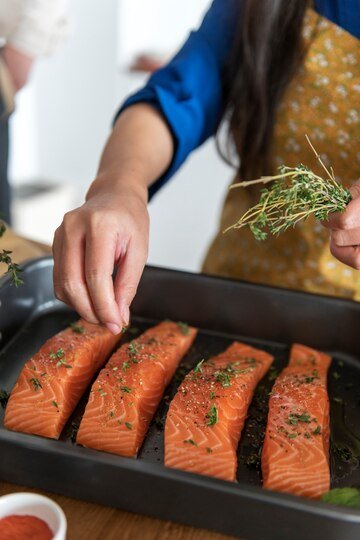How to
How to Cook Salmon: A Comprehensive Guide

Cooking salmon, a nutritious and versatile fish, can be an enjoyable experience with the right techniques and tips. This comprehensive guide will explore various methods, from baking to grilling, ensuring your salmon is perfectly cooked every time. With its rich, buttery flavor and numerous health benefits, salmon is a favorite among many. Whether you’re a seasoned chef or new to the kitchen, this article will provide you with everything you need to know about cooking salmon to perfection.
Understanding Salmon
Selecting the Best Salmon
Before diving into cooking methods, it’s crucial to know how to select the best salmon. Look for fresh, bright, and moist fillets or steaks. The flesh should be firm to the touch and free of any fishy odor. Wild-caught salmon often offers superior flavor and texture compared to farmed varieties, though both can be excellent choices depending on your preference and availability.
The Nutritional Value of Salmon
Salmon is not only delicious but also packed with nutrients. It is an excellent source of high-quality protein, vitamins (such as B12 and D), and minerals like potassium. The star nutrient in salmon is omega-3 fatty acids, known for their heart health and anti-inflammatory properties.
Preparing Salmon for Cooking
Cleaning and Marinating
Proper preparation is key to maximizing flavor and texture. Begin by rinsing your salmon under cold water and patting it dry with paper towels. Depending on your recipe, you may want to marinate the salmon to infuse it with additional flavors. Simple marinades can include ingredients like lemon juice, olive oil, herbs, and spices.
Portioning and Skinning
If your salmon hasn’t been pre-portioned, you may want to cut it into servings of about 6-8 ounces each. This ensures even cooking. Whether to skin your salmon is a matter of personal preference and cooking method. Some methods, like pan-searing, benefit from leaving the skin on to achieve a crispy texture.
Cooking Methods
Baking Salmon
Baking is a foolproof method for cooking salmon. Preheat your oven to 375°F (190°C), place your salmon on a lined baking sheet, and season as desired. Bake for 12-15 minutes or until the salmon easily flakes with a fork. This method is excellent for achieving tender, moist salmon.
Foil Wrapping for Moisture Retention
Wrapping salmon in foil with a bit of liquid (like white wine or lemon juice) and aromatics can create a steamy environment, ensuring the salmon stays moist and flavorful.
Grilling Salmon
Grilling imparts a smoky flavor that pairs wonderfully with salmon. Preheat your grill to medium-high heat, and lightly oil the grill grates. Place the salmon skin-side down and grill for 6-8 minutes per side, or until the skin is crispy and the fish flakes easily. Brushing the salmon with a glaze during the last few minutes of grilling can add a delicious caramelized layer.
Pan-Searing Salmon
For a crispy skin and tender interior, pan-searing is the way to go. Heat a non-stick skillet over medium-high heat with a bit of oil. Place the salmon skin-side down, pressing gently to ensure even contact with the pan. Cook for about 4-5 minutes per side, depending on thickness. This method is quick and yields a deliciously crispy skin.
Poaching Salmon
Poaching involves cooking salmon in a simmering liquid, such as water, broth, or wine, infused with herbs and spices. This gentle cooking method is ideal for keeping salmon moist and tender. Bring your poaching liquid to a simmer, add the salmon, and cook for about 10-15 minutes or until cooked through. Poached salmon is perfect for salads and cold dishes.
Serving and Pairing Salmon
Flavorful Accompaniments
The rich flavor of salmon pairs well with a variety of sides. Consider serving it with roasted vegetables, quinoa, or a fresh salad. For a heartier meal, pair salmon with mashed potatoes or rice pilaf.
Sauces and Seasonings
A simple sauce or a sprinkle of fresh herbs can elevate your salmon dish to the next level. Try a dill yogurt sauce, a soy ginger glaze, or a squeeze of lemon for a burst of flavor.
Conclusion
Cooking salmon can be a rewarding experience, offering a delicious and healthy addition to your meal rotation. By following the tips and techniques outlined in this guide, you’ll be well on your way to mastering the art of cooking salmon. Whether baked, grilled, pan-seared, or poached, salmon offers versatility and flavor that can be adapted to suit any taste or occasion. Enjoy the process and the delightful meals that result from your efforts.
Cooking salmon is an art and a science, requiring attention to detail but also allowing for creativity and personalization. Whether you’re preparing a weeknight dinner or a special meal for guests, salmon can be the star of the show with its rich flavor and nutritious profile. As you become more familiar with the various cooking methods, feel free to experiment with different seasonings, marinades, and sauces to create your own signature salmon dishes.



















